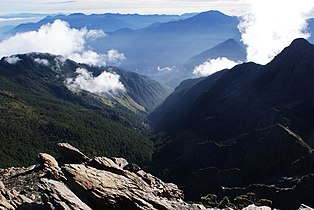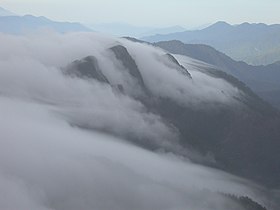Yushan National Park
| Yushan National Park 玉山 國家 公園 |
||
|---|---|---|
| Yushan peak in winter | ||
|
|
||
| Location: | Taiwan | |
| Surface: | 103.121 km² | |
| Founding: | April 10, 1985 | |
| Visitors: | 1,167,291 (2016) | |
| Address: | www.ysnp.gov.tw | |
The Yushan National Park ( Chinese 玉山 國家 公園 , Pinyin "Yù Shān Gúojiā Gōngyuán" ) is one of the eight national parks in Taiwan and was named after Yushan , the highest peak in the park. The park covers a total of 103,121.4 hectares, the majority of which is part of the Taiwanese Central Mountains . The park contains over 30 peaks, the elevation of which is more than 3000 meters. Two thirds of the area of the park are over 2000 meters above sea level. The height difference in the park is 3600 meters, and there are many gorges, cliffs and valleys.
history
During the Japanese colonial era , the park now known as Yushan National Park was founded as "Niitaka Arisan National Park (Japanese: 新 高 阿里山 国立 公園)". Niitaka Arisan National Park was established on December 27, 1937, but dissolved after Japan's defeat in World War II and the end of Japanese rule over Taiwan. After that, the government of the Republic of China moved to Taiwan and passed the National Park Act. In 1972 the National Park Act was officially implemented. In March 1979, adopted the Executive Yuan to "comprehensive development plan" Taiwan ( Taiwan Comprehensive Development Plan ), the Yushan , Kenting , Xueshan and Dabajian Snow mountain, Taroko and Lan Yu (Orchid Island) classified as national parks. On April 10, 1985, the office of the Yushan National Park Rangers (Chinese: 玉山 國家 公園 管理 wurde) was inaugurated. Yushan National Park is not only the largest national park, but also the first mountain national park in Taiwan.
In 2011 the park was added to the list of potential World Heritage Sites in Taiwan , which was drawn up by the Taiwanese Ministry of Culture in preparation for a possible acceptance of Taiwan into UNESCO. The criteria for this were the geological features and the rich flora and fauna in the park.
The area of 105.490 km² of the national park extends over three districts and one city and includes parts of the following municipalities or districts: Xinyi (24.065 km², Nantou district ), Alishan (1.515 km², Chiayi district ), Tauyuan (36.670 km², Kaohsiung ) and Zhuoxi (43.240 km², Hualien County ).
geomorphology
The island of Taiwan , which owes its existence to plate tectonics , is still a site of regular seismic activity. Yushan National Park is located in the central area of the island of Taiwan. The oldest geological terrain for the park consists of the Tananao Shale Complex ( 大 南澳 片岩 ), which is composed of various schists and metamorphic limestones and is located on the east side of the Taiwan Central Mountains . Examples of geological features such as fault lines, rock fissures, and folding can be seen throughout Yushan National Park:
- Large steep wall ( 大 峭壁 , Great Precipice ), 1.2 km before the Paiyun Hut (Chinese: 排 雲 山莊 , Paiyun Lodge ) on the Yushan Trail.
- Scree slope at the foot of the main summit
- Fractional stage in Laonong ( 荖 濃 ) between main peak and Batongguan ( 八 通 關 )
- Fuzi Cliff ( 父子 斷崖 ) and Guanshan Cliff ( 關 山 斷崖 )
flora
Due to its topography and unique landscape, Yushan National Park is known for its diverse climatic zones and rich biodiversity . The plant species found in the park range from subtropical (in the foothills) to high alpine (near the peaks). The frequent alternation of heights, steep cliffs, and deep valleys in Yushan National Park gives the park very unstable weather conditions. There can be very rapid temperature changes. Therefore, the variety of plants found here is remarkable. With only 3% of Taiwan's total land area, the park is still home to half of the native plant species. Research found 2,522 different types of plants in the park. With increasing height there are the following six vegetation zones in the park:
| Zone | Altitude | Characteristics |
|---|---|---|
| Deciduous forest zone | Below 1,800 meters | The deciduous forest is mainly dominated by trees of the laurel family and beech family and forms the mixed forest zone. The second tree layer consists of members of the beech family , such as Cyclobalanopsis morii, Castanopsis carlesii and Lithocarpus amygdalifolius. The base layer includes plants such as ferns and bracken . |
| False cypress zone | 1,800–2,500 meters | There are some false cypress forests in this area . |
| Chinese hemlock zone | 2,500–3,500 meters | The conifers Chamaecyparis formosensis (Chinese: 紅 檜), Chamaecyparis obtusa var.Formosana (Chinese: 台灣 扁柏), Taiwan cryptomerioides Hayata (Chinese: 台灣 杉), Chunninghamia konishii Hayata (Chinese: 巒 大 杉), Pseudotsuga. Wilsoniana grow in this zone (Chinese: 台灣 黃 杉) and the deciduous trees Acer morrisonensis Hayata (Chinese: 臺灣 紅 榨 槭) and Acer serrulatum Hayata (Chinese: 青楓). Chamaecyparis Formosensis and Chamaecyparis obtusa var. Formosana are commonly referred to as cypress. |
| Formosa fir zone | Approx. 3,530 meters | Groups of Formosa fir trees grow on the western slopes of Yushan . |
| Subalpine shrub zone | 3,500–3,800 meters | Dwarf plants that prostrate and grow leeward are the dominant vegetation types in this area. |
| Alpine herb zone | Over 3,800 meters | In summer, herbaceous plants such as Adenophora uehatae Yamamoto (Chinese: 高山 沙參), Leontopodium microphyllum Hayata (Chinese: 玉山 薄 雪 草), Sedum morrisonensis Hayata (Chinese: 玉山 佛 甲 草) and Gentiana arisanensis Hayata (Chinese:阿里山 龍膽). |
fauna
The park is home to a wide variety of birds, mammals, reptiles, amphibians, and butterflies. Between the months of March and May, visitors have the chance to watch butterflies migrate. The table below shows how many different types of animals have been found in the park.
| mammal | Reptiles | Amphibian | insects | Birds | fishes |
|---|---|---|---|---|---|
| 50 | 18th | 13 | 780 | 151 | 12 |
In the past, many of these species were threatened by overhunting. But with the establishment of Yushan National Park, the populations came back. Now sometimes larger mammals such as the Taiwanese black bear , the Formosa sambar deer , the Formosa macaque and the Taiwan serau can be observed again.
heritage Site
Prehistoric relics such as stone tools and pottery found in the Wangshiang (Chinese: 望 鄉) and Dongpu (Chinese: 東埔) areas attest to early human settlement. The indigenous Bunun tribe currently inhabit the villages of Dongpu and Meishan (Chinese: 梅山). He migrated from the coastal plains to the mountains about 300 years ago. Another indigenous tribe, the Tsou , who lived in the west of the park, were largely assimilated by the Bunun. The construction of the 100 km long Batongguan Trail (Chinese: 八 通 關 古道) in 1874 led to the displacement of the indigenous tribes. Some stone stairs, walls and guard posts are remnants from this past.
Ecotourism
In order to develop ecotourism , protection laws were passed on the one hand to promote public awareness of the importance of nature conservation, and on the other hand, public facilities were made available for easy access. Public facilities in the park include:
| Network of hiking trails (meters) | Parking spaces | Safety rails for hiking trails (meters) | Suspension bridges | Weatherproof shelters | Sewage treatment plants | Tourist centers | training centre |
|---|---|---|---|---|---|---|---|
| 39,880 | 17th | 1,111 | 18th | 13 | 2 | 3 | 1 |
Many bridges and wooden paths have been installed for public safety on difficult terrain.
There are three visitor centers in the park:
- Tataka visitor center (English)
- Nanan visitor center (English)
- Meishan visitor center (English)
gallery
See also
Individual evidence
- ↑ "National Parks in Taiwan (English)
- ↑ "About Yushan National Park" (Chinese)
- ^ "Laws & Regulations Database of The Republic of China" (English)
- ↑ "National Parks of Taiwan Digital Archive" (Chinese)
- ^ Bureau of Cultural Heritage: Yushan National Park. Retrieved June 15, 2020 (chin).
- ↑ 各 國家 公園 基本 資料 表 (“Basic information table about the national parks”). (pdf) (No longer available online.) October 12, 2010, formerly in the original ; Retrieved October 26, 2018 (Chinese). ( Page no longer available , search in web archives ) Info: The link was automatically marked as defective. Please check the link according to the instructions and then remove this notice.
- ↑ "Flora in Yushan National Park" (English)
- ↑ "Fauna in Yushan National Park" (Chinese)
- ↑ "Public Facilities in Yushan National Park" (English)






